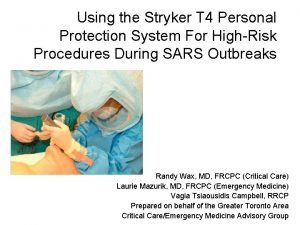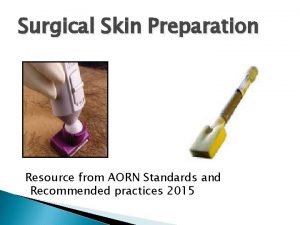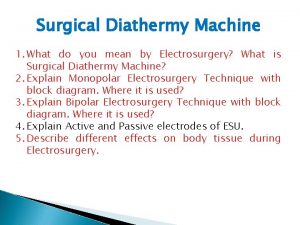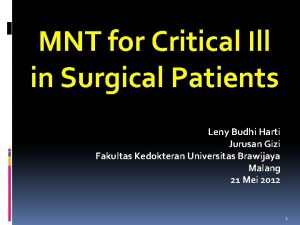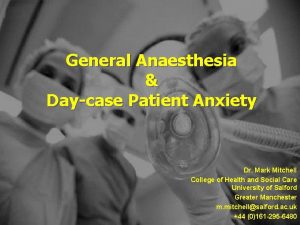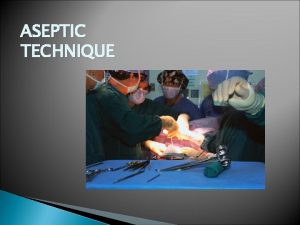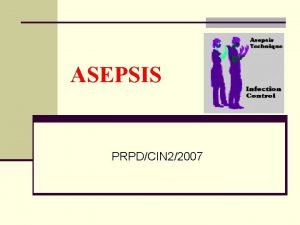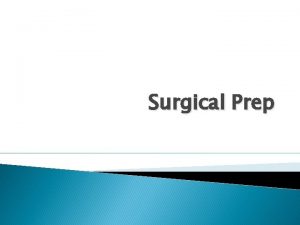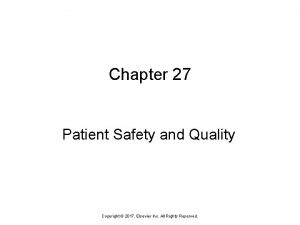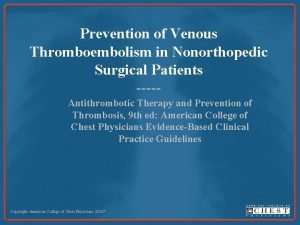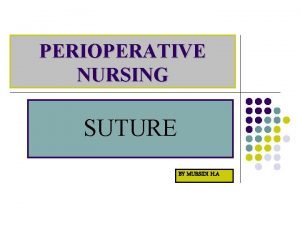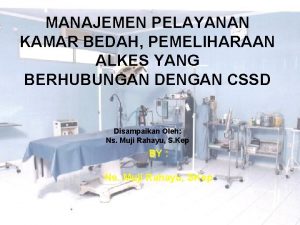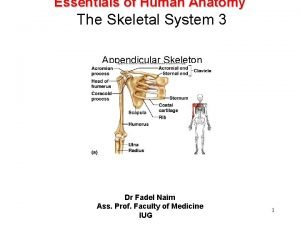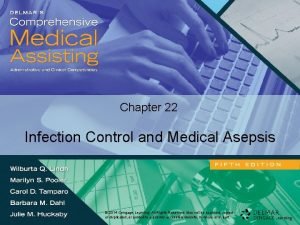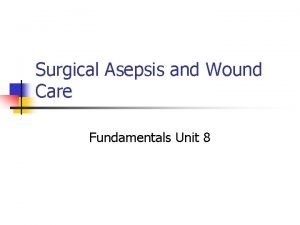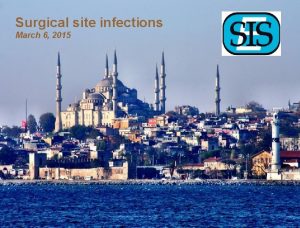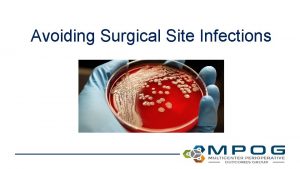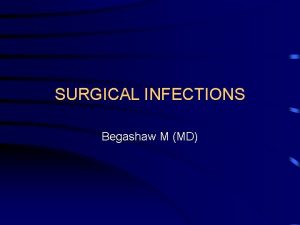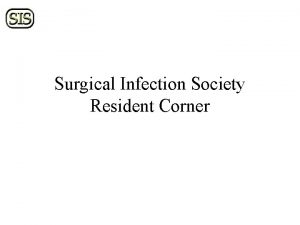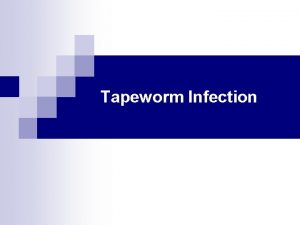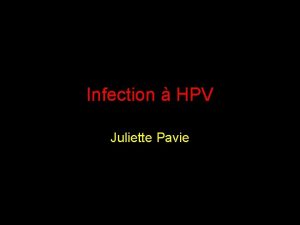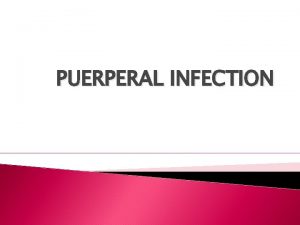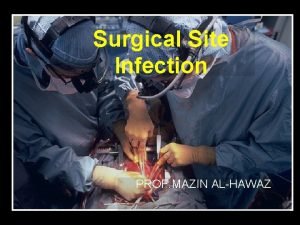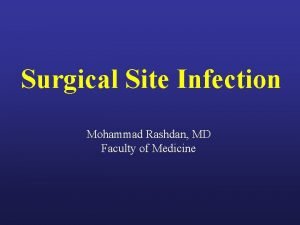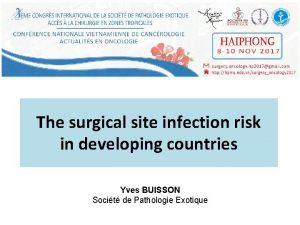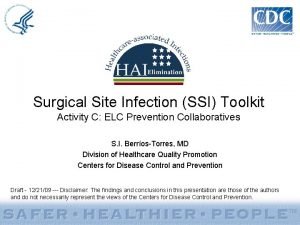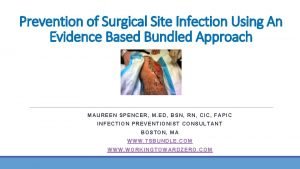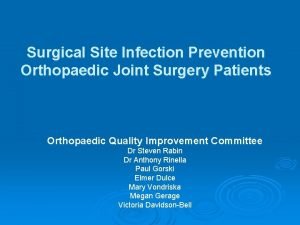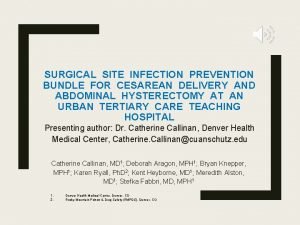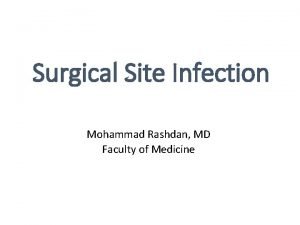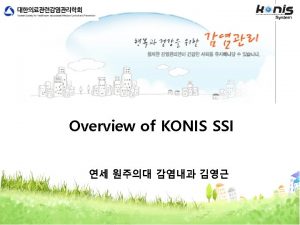surgical site infection What is surgical site infection




































- Slides: 36

surgical site infection

What is surgical site infection? Discuss the methods to reduce surgical site infection. Enumerate the factors responsible for surgical site infection.

Nosocomial Infection An infection acquired in hospital by a patient who was admitted for a reason other than that infection. Infections occurring for more than 48 hours after admission are usually considered nosocomial Amongst surgical patients, SSI are the most common nosocomial infections

Classes of SSI Superficial incisional SSI: Infection occurs within 30 days after the operation and infection involves only skin of subcutaneous tissue of the incision and at least one of the following: – 1–Purulent drainage with or without laboratory confirmation from the superficial incision – 2–Organisms isolated from an aseptically obtained culture of fluid or tissue from the superficial incision

– 3–At least one of the following signs or symptoms of infection: --Pain or tenderness --Localised swelling --Redness --Heat --And superficial incision deliberately opened by a surgeon, unless incision is culture negative

Deep incisional SSI: Infection occurs within 30 days after the operation if no implant is left in place or within one year if implant is in place and the infection appears to be related to the operation and infection involves deep soft tissues (e. g. fascial and muscle layers) of the incision and at least one of the following:

– 1–Purulent drainage from the deep incision but not from the organ/space component of the surgical site – 2–A deep incision spontaneously dehisces or is deliberately opened by a surgeon when the patient has at least one of the following signs or symptoms: --Fever (>38°C) --Localized pain --Tenderness unless site is culture-negative – 3–An abscess or other evidence of infection involving the deep incision is found on direct examination, during re-operation or by histopathological or radiological examination

Organ/space SSI: Infection occurs within 30 days after the operation if no implant is left in place or within one year if implant is in place and the infection appears to be related to the operation and infection involves any part of the anatomy (e. g. organs or spaces), other than the incision, which was opened or manipulated during an operation and at least one of the following:

– 1–Purulent discharge from a drain that is placed through a stab wound into the organ/ space – 2–Organisms isolated from an aseptically obtained culture of fluid or tissue in the organ/space – 3–An abscess or other evidence of infection involving the organ/space that is found on direct examination, during reoperation, or by histopathologic or radiological examination

Strategies to prevent SSI Objectives 1 -Reduce the inoculum of bacteria at the surgical site 2 -Surgical site preparation 3 -Antibiotic prophylaxis strategies 4 -Optimize the microenvironment of the surgical site 5 -Enhance the physiology of the host (host defenses)

risk factors of SSI classified as: 1 -Patient-related (intrinsic) 2 -Preoperative 3 -Operative

Patient-related factors a-Diabetes—recommendation Preoperative Control serum blood glucose—reduce Hb. A 1 C levels to <7% before surgery if possible Maintain the postoperative blood glucose level at less than 200 mg/d. L b-Smoking, anemia, malnutrition c-Hypoalbuminemia, jaundice d-Obesity, hyperlipidemia e-Ascites, PVD f-Immunosupression.

2 -Procedure-related risk factors a-Hair removal technique (clipping> on table shaving > previous night shaving) b-Preoperative infections control and bath c-Surgical scrub d-Skin preparation e-Antimicrobial prophylaxis f-Surgeon skill/technique/instruments g-Asepsis h-Operative time (should be within 1. 5 times the normal) j-Operating room characteristics/OT sterility.

Surgeon skill and technique Excellent surgical technique reduces the risk of SSI Includes a-Gentle traction and handling of tissues b-Effective hemostasis c-Removal of devitalized tissues d-Obliteration of dead spaces e-Irrigation of tissues with saline during long procedures f-Use of fine, nonabsorbed monofilament suture material h-Wound closure without tension.

Cellulitis is a common infection of skin and subcutaneous tissues, most frequently caused by Streptococcus pyogenes and occasionally Staphylococcus species. Infection occurs after the skin is breached (e. g. insect bite, scratching, skin rash, minor trauma).

Cellulitis may seem to occur spontaneously, although careful inspection reveals a break in the skin After subcutaneous inoculation, streptococci release toxins which permit rapid spread of organisms. The acute inflammatory response results in the clinical features of warmth, pain and tenderness, erythema, and oedema. Severe cellulitis may progress to suppuration and skin necrosis.

Differential diagnosis includes other causes of limb swelling, deep venous thrombosis, rupture of a Baker’s cyst, calf haematoma and erythematous skin conditions.

excretion of penicillin. Erythromycin or a third generation cephalosporin is used in patients with penicillin allergy. Any predisposing cause (e. g. tinea pedis) is treated vigorously. If cellulitis does not resolve rapidly, the antibiotic is increased or changed.

Lymphangitis is associated with bacterial infections of extremities where the inflamed lymphatic vessels appear as several thin, red, tender lines on the slightly oedematous skin progressing towards the regional lymph nodes which are enlarged and tender (lymphadenitis).

Cellulitis of an extremity is treated by elevation and immobilisation with a splint or plaster ‘back slab’, and antibiotics. Penicillin (2 million units every 6 hours) or flucloxacillin (1– 2 g every 6 hours) is given intravenously for 3– 5 days and then continued orally for a further 10 days. Blood levels of penicillin may be increased by oral probenecid, which reduces renal

Lymphangitis usually is caused by streptococci and staphylococci. Chemical lymphangitis may result from irritative compounds used for lymphangiography.

Treatment is the same as for cellulitis, consisting of rest and elevation of the extremity and antibiotics. Rarely, suppurative regional lymph nodes require surgical drainage.

Folliculitis, furuncles and carbuncles ‘Folliculitis’ refers to infection with pus formation within a hair follicle and is limited to the dermis. It may be extensive if many follicles are infected over a wide area, such as the face.

A ‘furuncle’ is infection of a small number of hair follicles within a small confined area. A ‘carbuncle’ is an abscess involving a number of adjacent hair follicles where the infection has penetrated through the dermis and formed a multiloculated subcutaneous abscess between the fibrous septa which anchor the skin to the deep fascia

Furuncles and carbuncles occur most frequently on the back of the neck, lower scalp, and the torso. Abscesses on the upper part of the body are usually caused by staphylococci, while infections below the umbilicus are due largely to aerobic and anaerobic coliform organisms.

Local hygiene is usually sufficient to treat folliculitis, although antibiotics are required for extensive infections. Furuncles and carbuncles require incision and drainage. Fibrous tissue septa must be broken down so that all pockets of pus can be drained completely. Antibiotics are indicated for severe and spreading infections, and in immunocompromised patients.

Hidradenitis suppurativa refers to infection of apocrine sweat glands, and occurs in the axillae, around the external genitalia, and the inguinal and perianal regions

Apocrine sweat glands have tortuous secretory ducts within the skin and produce thick secretions, and infection occurs when ducts become blocked, most commonly during excessive glandular activity at adolescence. Staphylococci or Gramnegative bacilli and anaerobes are causative organisms.

Patients present with multiple small but painful abscesses and sinuses, often bilaterally. Repeated or long-standing infection results in considerable scarring,

Antibiotic therapy alone is often inadequate, although long-term antibiotic therapy may be useful in suppressing acute infections. Abscesses require incision and drainage. Excision of the affected hair-bearing area and the subcutaneous fat usually is required, and results in good symptomatic relief.

Synergistic gangrene ‘Synergistic gangrene’ refers to a group of soft tissue infections characterised by tissue necrosis and caused by several species of microorganisms acting synergistically. Previous nomenclature (necrotising fasciitis, necrotising erysipelas, Meleney’s gangrene, Fournier’s gangrene, non-clostridial gangrenous cellulitis)

Clinical features Synergistic gangrene is caused by micro-aerophilic streptococci acting synergistically with aerobic staphylococci, with or without Gram-negative bacilli. It usually occurs in debilitated patients with other disorders (e. g. diabetes, malnutrition, alcoholism, liver disease, renal failure, malignant disease, immune compromise).

Synergistic gangrene presents initially as cellulitis with severe pain which is out of keeping with the minor local clinical signs but consistent with the seriousness of the condition. Infection spreads rapidly along fascial and subcutaneous planes without a severe inflammatory reaction.

Bacterial toxins cause tissue and skin necrosis. Crepitus occurs when gas-forming organisms are present. Signs of systemic sepsis and toxaemia occur quickly. ‘Fournier’s gangrene’ is the name given to synergistic gangrene involving the perineum and scrotum. It may be extensive and involve the abdominal wall and buttocks, and is a rare complication of anorectal and perineal surgery, trauma or minor infection.

Treatment Synergistic gangrene must be treated urgently by

Select the single correct answer to each question. 1: Cellulitis: a-is occasionally caused by Gram-negative coliforms b-often occurs spontaneously without any apparent cause or organism c- is treated with rest, immobilisation and high-dose penicillin d-frequently requires surgical drainage e-is often complicated by suppuration and skin necrosis 2: Fournier’s gangrene: a-is a form of pyomyositis b-occurs mainly in debilitated patients and can be life-threatening c -is usually due to stapylococcal infection d-can be treated by hyperbaric oxygen alone e-is seldom managed surgically
 Surgical site infection bundle checklist
Surgical site infection bundle checklist Lyphadenitis
Lyphadenitis Hot site cold site warm site disaster recovery
Hot site cold site warm site disaster recovery Gordochom precio
Gordochom precio Stryker surgical helmet
Stryker surgical helmet Surgical sieve vitamin c
Surgical sieve vitamin c Betadine scrub and paint
Betadine scrub and paint Surgical education week
Surgical education week Surgical diathermy machine
Surgical diathermy machine Surgical audit definition
Surgical audit definition What is the horizontal recumbent position used for
What is the horizontal recumbent position used for Surgical metabolism
Surgical metabolism Surgical metabolism
Surgical metabolism Surgical planning laboratory
Surgical planning laboratory Surgical metabolism
Surgical metabolism Conclusion of medical surgical nursing
Conclusion of medical surgical nursing A nurse floats to a busy surgical unit
A nurse floats to a busy surgical unit Aseptic technique clipart
Aseptic technique clipart N
N Care of the critically ill surgical patient
Care of the critically ill surgical patient Surgical prep
Surgical prep Avagard surgical scrub instructions
Avagard surgical scrub instructions Stapler history
Stapler history Chapter 27 patient safety and quality
Chapter 27 patient safety and quality Roles and responsibilities of healthcare team
Roles and responsibilities of healthcare team Prevention of vte in nonorthopedic surgical patients
Prevention of vte in nonorthopedic surgical patients Color coding of sutures
Color coding of sutures Maintenance of surgical instruments
Maintenance of surgical instruments Congenital flat foot
Congenital flat foot Chapter 22 surgical asepsis
Chapter 22 surgical asepsis Deltoid tuberosity
Deltoid tuberosity Inet wellspan
Inet wellspan Hematology suffix
Hematology suffix Aorn surgical hand scrub
Aorn surgical hand scrub Surgical bandage types
Surgical bandage types Rutherford-morrison scar
Rutherford-morrison scar Qrc surgical
Qrc surgical




